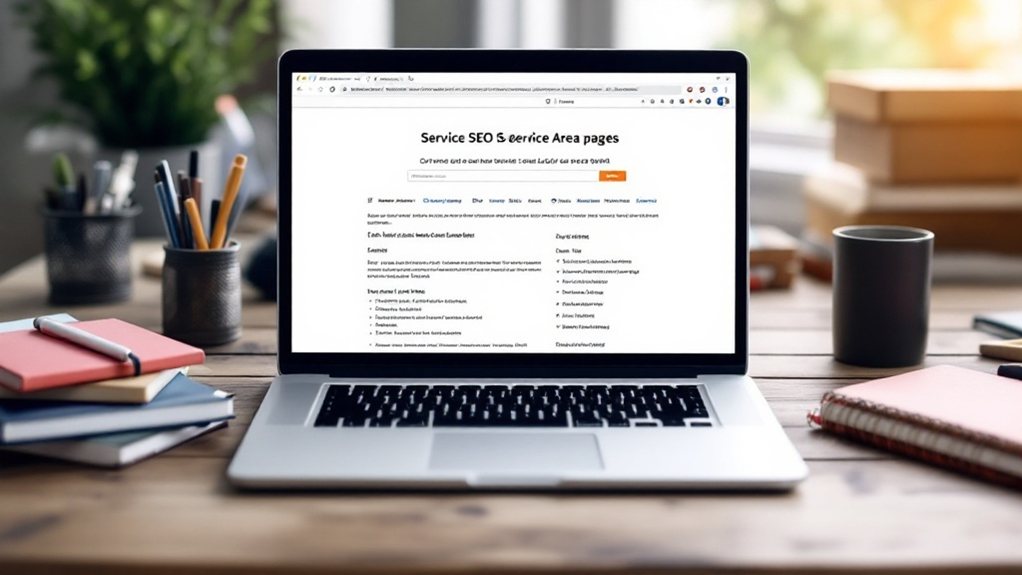To structure your service area pages for local SEO, start with a clear URL structure that organizes your services and locations using subfolders. Optimize page titles to reflect your specific offerings and target keywords. Craft compelling meta descriptions that highlight your unique services and speak directly to your audience. Leverage detailed, localized content with customer testimonials to showcase your expertise. Implement comprehensive technical optimization, like responsive design and strategic internal linking, to guide users and search engines. Continue reading to learn more about these and other local SEO best practices.
Clear URL Structure

A clear URL structure is essential for effective local SEO. Organize your services and locations using subfolders to provide clarity and SEO benefits. Ensure your URLs are free from query strings and parameters for better readability and usability. Strategically include relevant keywords to enhance visibility, and maintain a consistent, hierarchical structure to facilitate navigation. Leverage HTTPS to secure browsing and improve search rankings. Keep URLs concise and descriptive, using hyphens to separate words and lowercase letters consistently. Include location data, such as "domain/service/city," and create specific landing pages for each service area to target local SEO. Regularly audit your URLs to maintain consistency and clarity.
Optimized Page Titles

Crafting optimized page titles for your service area pages is crucial for effective local SEO. Ensure your titles reflect the specific services offered in each area and include target keywords. Position primary keywords at the beginning and incorporate long-tail phrases to target specific searches. Title tags are a small ranking factor in Google's search algorithms. Use unique phrases to engage users, and avoid generic terms like "Home." Balance title length, aiming for under 60 characters, and use title case for readability. Remember to include your business name for branding, use location names, and reflect the page content accurately. Following these best practices will help your service area pages stand out and effectively reach your local audience.
Compelling Meta Descriptions

Your meta descriptions are your chance to make a great first impression and entice users to click through to your website. Craft descriptions that highlight your unique service offerings, using compelling language that speaks directly to your target audience. Optimizing these bite-sized snippets can help showcase your local expertise and why customers should choose your business.
Crafting Attention-Grabbing Descriptions
As the gateway to your service area pages, compelling meta descriptions play a crucial role in capturing user attention and driving click-throughs. Remember, these snippets serve as a pitch in search results, so they should include relevant location and service keywords while adhering to Google's best practices. Keep your descriptions concise, within 150-160 characters, and use compelling language to entice users. Ensure the content accurately reflects the page, and leverage meta description length checker tools for optimization. Conducting keyword research is essential to identify the most relevant and high-performing keywords for the local SEO strategy. For improved local visibility, incorporate location-specific keywords and maintain consistent NAP (name, address, phone) across all platforms. By crafting attention-grabbing descriptions, you can enhance the user experience and boost your local SEO.
Highlighting Unique Service Offerings
To effectively highlight your unique service offerings, it's crucial to optimize your page titles and meta descriptions with relevant, service-specific keywords. Conduct thorough market research to understand how your services differ from competitors, and leverage that information to craft compelling copy. Incorporate local data and landmarks to connect with your target audience, and use visuals that showcase your unique value proposition.
| Keyword Optimization | Service Variety | Competition Analysis | Local Integration |
|---|---|---|---|
| Include service-specific keywords in page titles and descriptions to enhance search visibility. | Offer diverse services catering to different customer needs in a service area. | Conduct market research to understand unique offerings compared to competitors. | Integrate local data and landmarks into service descriptions to connect with the local audience. |
| Visual Content | Meta Description Length | Unique Selling Points | Local Relevance |
| Use images or videos that highlight unique service aspects and local relevance. | Ensure meta descriptions are concise and within the recommended character limit. | Highlight what sets the service apart from competitors in the meta description. | Include location-specific information to attract local search traffic. |
Strategic Keyword Research
Conducting strategic keyword research is paramount when optimizing service area pages for local SEO. Understanding that 46% of Google searches have local intent underscores the need for targeted keyword strategies. Nearly 88% of people who search for a local business on their phone take action within 24 hours. Leverage tools like Ahrefs and SEMrush to identify competitor keywords and find gaps in your current approach. Incorporate geographic modifiers, prioritize keywords with good search volume and manageable competition, and utilize Google Trends to stay ahead of emerging local trends. Optimize your content with seed keywords, long-tail phrases, and question-based queries. Continuously refine your strategy based on market shifts and competitor analysis to ensure you're attracting the right local customers.
Localized Content Creation
Optimizing your service area pages for local SEO goes beyond just keyword research. Crafting localized content is crucial to connect with your target audience and boost visibility in local search results. Incorporate culturally relevant phrases, highlight community involvement, and tailor content to engage local customers. Utilize tools like Google Keyword Planner to find local keywords and phrases relevant to the business and local area. Leverage local resources, such as news, events, and keywords, to stay fresh and relevant. Ensure your URLs, page structure, and internal linking are optimized for both users and search engines. Monitor engagement metrics and adjust your strategy accordingly. By creating localized content, you can establish a stronger connection with your local community and improve your local SEO impact.
Detailed Service Information
Providing detailed service information is crucial for showcasing your expertise and differentiating your offerings. Highlight the unique characteristics of your services in each location, and use customer testimonials to build trust. Leverage comparison tools to help visitors easily evaluate the services that best suit their needs. Ensure the service information is consistently updated to reflect any changes or new offerings.
Comprehensive Service Details
Detailed and comprehensive service descriptions are crucial for effectively communicating your business's offerings to potential customers. Highlight the unique aspects of each service, addressing specific needs and questions. Use bullet points or numbered lists to make the content more readable and scannable. Enhance understanding and engagement with visuals, such as images and videos, optimized for SEO. Feature testimonials and reviews to build trust and improve search engine rankings. Showcase your local connection by mentioning landmarks, events, partnerships, and community involvement. Integrate relevant keywords throughout, including location-based terms, to boost visibility in local searches. Ensure clear navigation and mobile optimization for an exceptional user experience.
Service Specifics by Location
When it comes to your service area pages, it's crucial to dive deep into the specifics of the services you offer in each location. Provide detailed descriptions of the services available in each service area, highlighting any unique local services that cater to specific needs or characteristics of the region. Utilize area-specific keywords and long-tailed keywords to ensure your content is optimized for relevant local searches. Prioritize services based on local demand or potential customer needs to ensure you're addressing the right priorities. Location pages help organize information in a way that search engines can easily understand. By focusing on the service specifics by location, you can create a valuable and informative resource for your local audience, boosting your search visibility and customer engagement.
Emphasize Local Relevance
To ensure your service area pages truly resonate with your local audience, you'll want to emphasize the local relevance of your offerings. Highlight local landmarks, community events, and cultural details to demonstrate your understanding of the area. Feature partnerships with other trusted local businesses, and share insights from your customers about your services. Tailor your content to speak directly to the needs and interests of your local community. By demonstrating your deep connection to the area, you'll build credibility and trust, driving more qualified leads and conversions.
Leveraging Customer Testimonials
Because customer testimonials can significantly impact local SEO, you'll want to leverage them effectively. Positive reviews enhance your credibility, boost click-through rates, and improve your local relevance. Incorporate location-specific keywords in testimonial responses for better geo-targeted results. Showcase diverse reviews across platforms to appeal to a broader audience. Regularly update and refresh your testimonials to keep the content fresh. Utilize tools like Yotpo to display them prominently on your website. By actively collecting and strategically showcasing customer feedback, you can gain a competitive advantage and improve your local search visibility.
Comprehensive Technical Optimization
Effective local SEO goes beyond just creating great content – it requires comprehensive technical optimization as well. From structuring URLs to leveraging schema markup, a holistic approach is key. Ensure your service area pages load quickly on mobile, implement responsive design, and prioritize mobile-first indexing. Use schema to highlight business details, services, and rich snippets. Optimize page speed through file compression and browser caching. Establish strategic internal linking to guide users and search engines. Finally, track performance, analyze traffic, and A/B test to continually refine your optimization strategies.
| URL Structure | Mobile Optimization | Schema Markup | Site Performance |
|---|---|---|---|
| Incorporate service and location | Responsive design | LocalBusiness schema | Page load times under 3 seconds |
| Add to XML sitemap | Mobile-first indexing | Service-specific schema | Implement browser caching |
| Keyword-rich URLs | Fast mobile load times | Rich snippets | Leverage file compression |
Implementing Local SEO Best Practices
Optimizing your Google My Business profile, maintaining consistent NAP (Name, Address, Phone) citations, and leveraging local keywords are essential for boosting your service area pages' visibility in local search. By focusing on these key tactics, you can improve your overall local SEO strategy and attract more customers searching for your services in their specific locations. Implementing these best practices will help you establish a stronger online presence and increase your chances of ranking higher in search engine results.
Optimize Google My Business
Establishing an accurate and comprehensive Google My Business (GMB) profile is crucial for local businesses looking to enhance their visibility in search results. Ensure your GMB listing has complete and up-to-date information, including your address, phone number, business hours, and relevant categories. Incorporate targeted keywords in your description to improve local search rankings. Regularly monitor and respond to customer reviews, as positive feedback can significantly boost your reputation and attract new clients. Utilize Google Posts to share promotions, events, and other relevant updates. By optimizing your GMB profile, you'll increase your chances of appearing in local search results and connecting with your target audience.
Maintain Consistent NAP
Consistent management of your Name, Address, and Phone number (NAP) is vital for improving local search engine optimization (SEO). NAP consistency helps verify your business's legitimacy across online directories and listings. Ensure your NAP details are accurate and uniform across major platforms like Google My Business, Bing Places, and Yelp. Use Local Schema Markup, add NAP to your website's footer, and prioritize precision in formatting. Eliminate duplicate listings and promptly correct any inconsistencies. Regularly audit your NAP details and utilize tools to streamline the process. By maintaining consistent NAP, you'll boost your local search visibility and reinforce your business's credibility to search engines.
Leverage Local Keywords
Leveraging local keywords is key to enhancing your local SEO strategy. Identify relevant terms that your potential customers use to find services in your area through tools like Google Keyword Planner. Incorporate location-specific modifiers like "best" or "near me" to target specific search intents. Analyze your competitors' keyword strategies to uncover opportunities. Create niche-focused content that addresses local search intent, and optimize it with a balanced keyword density. Use local keywords in headings and subheadings, and develop dedicated landing pages for each service area. This targeted approach will improve your visibility in local search results and drive more qualified traffic to your website.
Ongoing Performance Monitoring and Refinement
Tracking your website's performance is crucial for refining your local SEO strategies. Use Google Analytics to analyze your website traffic, Google Search Console to monitor local search visibility, and Google Business Profile Insights to measure customer interactions.
To further optimize your service area pages:
- Regularly track your local search rankings and analyze organic traffic patterns across different geographic locations.
- Study conversion rates and lead quality from each service area page to identify opportunities for improvement.
- Ensure proper technical SEO, including mobile optimization, and enhance local relevance by mentioning geographic landmarks and community references.
